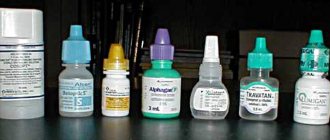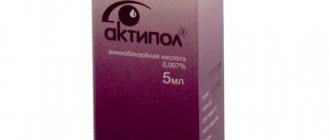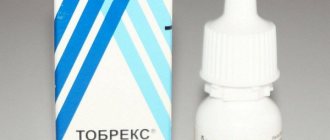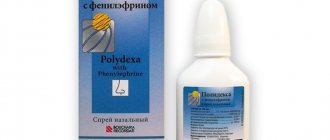Diclofenac eye drops 0.1% fl-cap 5ml
Compound
Active substance: diclofenac sodium - 1 mg. Excipients: sorbic acid - 1.5 mg, disodium edetate dihydrate - 0.1 mg (disodium salt ethylenediamine tetraacetic acid dihydrate), sodium hydrogen phosphate - 12 mg, dodecahydrate sodium hydroxide solution 1 M - up to pH 6.5-7.5 , sodium chloride - 5.5 mg, water-soluble methylcellulose - 6.5 mg, purified water - up to 1 ml.
Pharmacokinetics
The time to reach Cmax in the cornea and conjunctiva is 30 minutes after installation; penetrates the anterior chamber of the eye. It does not penetrate into the systemic circulation in therapeutically significant concentrations.
Indications for use
- inhibition of miosis during cataract surgery;
- prevention and treatment of cystic maculopathy after cataract surgery;
- inflammatory process of non-infectious nature;
- conjunctivitis, keratoconjunctivitis;
- postoperative and post-traumatic uveitis;
- keratitis;
- corneal erosion.
Contraindications
- hematopoiesis disorder of unknown origin;
- erosive and ulcerative processes in the gastrointestinal tract in the acute stage;
- hypersensitivity to acetylsalicylic acid or other NSAIDs;
- hypersensitivity to diclofenac and auxiliary components of the drug used.
With caution: epithelial herpetic keratitis (including history); bronchial asthma caused by taking acetylsalicylic acid; diseases that cause blood clotting disorders (including hemophilia, prolongation of bleeding time, bleeding tendency, hemorrhagic diathesis, use of anticoagulants); pregnancy; lactation period (breastfeeding); children and adolescents up to 18 years of age; elderly age.
Directions for use and doses
The frequency and duration of use are determined individually.
To inhibit intraoperative miosis
the drug is instilled into the conjunctival sac for 2 hours with an interval of 30 minutes (4 times in total) before surgery.
For the prevention of cystoid macular edema
the drug is instilled 1 drop 3-4 times a day for 2 weeks after surgery.
For other indications
- 1 drop 3-4 times a day, depending on the severity of the condition. The course of treatment can last from 1 to 2 weeks.
Storage conditions
In a place protected from light at a temperature not exceeding 15°C.
Protect from freezing. Keep out of the reach of children.
Best before date
2 years.
Do not use after the expiration date stated on the packaging. The shelf life of the drug after opening is 1 month.
special instructions
Intended for topical use only and not injected subconjunctivally or into the anterior chamber of the eye.
The anti-inflammatory effect of diclofenac may mask the symptoms of infections. If there is an infection or there is a threat of its development, local antibacterial treatment is prescribed simultaneously with the use of diclofenac.
In patients with bronchial asthma in combination with rhinitis or chronic sinusitis, since the risk of allergic reactions when using acetylsalicylic acid or NSAIDs is increased, the use of diclofenac may cause bronchospasm.
Description
NSAIDs for topical use in ophthalmology.
Dosage form
Transparent or slightly opalescent colorless or yellowish liquid.
Use in children
Use with caution in children and adolescents under 18 years of age.
Pharmacodynamics
NSAID, phenylacetic acid derivative. Has anti-inflammatory and analgesic effects. The mechanism of action is due to the indiscriminate inhibition of the activity of COX-1 and COX-2, which leads to the suppression of prostaglandin synthesis.
When applied topically in ophthalmology, it reduces swelling and pain during inflammatory processes of non-infectious etiology.
The use of diclofenac does not affect the time of wound regeneration.
Use during pregnancy and breastfeeding
Local reactions: burning of the eyes, blurred vision (immediately after instillation), clouding of the cornea (thorn), iritis.
From the digestive system: nausea, vomiting.
Allergic reactions: itching in the eyes, hyperemia, angioedema of the face, fever, chills, photosensitivity, skin rash (mainly erythematous, urticaria), exudative erythema multiforme.
Interaction
Instillation of NSAIDs, including diclofenac, into the conjunctival cavity along with corticosteroids in patients with severe corneal inflammation can lead to progression of corneal damage (caution is required with simultaneous use).
If simultaneous use with other eye drops - antibiotics and beta-blockers - is necessary, the interval between instillations should be at least 5 minutes to prevent leaching of the active substances with subsequent doses.
It is theoretically possible that the use of diclofenac eye drops with drugs that reduce blood clotting or in patients with reduced blood clotting may increase bleeding time.
Impact on the ability to drive vehicles and operate machinery
During the period of treatment with the drug, care must be taken when driving vehicles and engaging in other potentially hazardous activities that require increased concentration and speed of psychomotor reactions.
Diclofenac eye drops 1 mg/ml 5 ml bottle with dropper cap No. 1
International nonproprietary name: Diclofenac/Diclofenac Synonyms Diclogen, Diclo-F, Clodifen, Medinac, Naklof Pharmacotherapeutic group Non-narcotic analgesics, including non-steroidal anti-inflammatory drugs. Drugs for the treatment of eye diseases. Composition Each ml of solution contains: active substance: diclofenac sodium 1.0 mg. ATX code: S01BC03.
Pharmacological action Has anti-inflammatory and analgesic effects. In inflammatory processes that occur after operations and injuries, it quickly relieves spontaneous pain and reduces inflammatory swelling at the wound site. Its anti-inflammatory activity is superior to acetylsalicylic acid, butadione, and ibuprofen.
Indications for use: inhibition of miosis during cataract surgery; inflammatory process after surgery, prevention and treatment of cystoid edema of the retinal macula after surgical removal of cataracts; - inflammatory process of non-infectious nature: conjunctivitis, keratoconjunctivitis, corneal erosion, post-traumatic inflammation of the conjunctiva and cornea, photophobia after keratotomy; - treatment and prevention of post-traumatic inflammatory process in penetrating and non-penetrating wounds of the eyeball (as an addition to local antibacterial and antiviral therapy).
Directions for use and dosage regimen: Local. To inhibit intraoperative miosis, instill 1 drop into the conjunctival sac for 2 hours before surgery with an interval of 30 minutes (4 times); immediately after surgery - 1 drop 3 times, then - 1 drop 3-5 times a day for the time required for treatment. To prevent cystoid macular edema, 1 drop 3-4 times a day for 1 month. after operation. Other indications: 1 drop 3-5 times a day, depending on the severity of the condition. The course of treatment is 1-4 weeks.
Special instructions The use of diclofenac sodium eye drops masks the signs of a bacterial eye infection, so the possibility of sudden development of a bacterial infection while using the drug should be taken into account. With long-term use of the drug, it is necessary to regularly carry out preventive eye examinations, as well as monitoring intraocular pressure. Wearing contact lenses is not recommended during treatment. If it is impossible to refuse to wear contact lenses, they should be removed at least 5 minutes before instillation of the drug and placed back no earlier than 15 minutes after instillation. Prescribe with caution to patients with a history of allergies. If the irritant effect is pronounced, you should stop using the drug.
Side effects When using the drug, local tissue irritation (burning, redness, blurred visual perception (immediately after instillation), swelling, pain, lacrimation), allergic corneal opacification (thorn), iritis is possible; allergic reactions: itching in the eyes, hyperemia, angioedema of the face, fever, chills, photosensitivity, skin rash (mainly erythematous, urticaria), exudative erythema multiforme; nausea, vomiting.
Contraindications Hypersensitivity to diclofenac and other non-steroidal anti-inflammatory drugs, as well as to any of the auxiliary components of the drug. With caution: bronchial asthma caused by taking acetylsalicylic acid, epithelial herpetic keratitis (including a history); diseases that cause blood clotting disorders (including hemophilia, prolongation of bleeding time, bleeding tendency); pregnancy, lactation, children (up to 16 years) and old age.
Interaction with other drugs The combined use of diclofenac sodium eye drops with antiviral and antibacterial drugs in the form of eye drops and ointments, and ophthalmic corticosteroids is allowed. The break between applications should be at least 5 minutes to prevent leaching of the active substances with subsequent doses.
Precautionary measures Impact on the ability to drive a car and potentially dangerous mechanisms: be careful when driving vehicles and engaging in other potentially dangerous activities that require increased concentration and speed of psychomotor reactions.
Release form Solution (eye drops) 0.1%, 1 ml in dropper tube No. 2; in a bottle of 5 ml.
DICLOFENAC (drops)
The party carries certain information.
Here is the complete composition of the drops.
Manufacturer: Moscow Endocrine Plant.
A few tips for potential users: - use only if prescribed by a doctor, and not determine your own diagnosis; - the storage place should be difficult to reach for children, protected from light, the temperature should not exceed 15 degrees, - do not freeze; — after opening the bottle, the drug can only be used for 1 month, this is its shelf life.
Instructions for using the dropper bottle are presented in pictures and with a step-by-step description.
On the end sides of the box you can see the date of manufacture of the drops - this is the current year, they are good until 2021, that is, for two years, and there is also a barcode of the country of origin - Russia.
The price is cheap, at the pharmacy they put it with a marker right on the box, 35 rubles, just for nothing.
The bottle nestled comfortably inside the box, hugging the folded instructions.
INSTRUCTIONS.
The attached instructions must be read before using the drops; we already know some of the information about them, but it also indicates their properties, indications and contraindications, and side effects. We can draw the first conclusion: Diclofenac drops are suitable for us according to the indicated indications, as an anti-inflammatory drug to relieve swelling and pain that are caused by the inflammatory process, so the prescription was made correctly.
DROPPER BOTTLE. It is made of transparent plastic, with a small label on which the name of the drops, their purpose, volume, manufacturer and expiration date are duplicated.
The cap on the bottle is convenient; the first time you turn it clockwise, the top of the neck should be punctured, but alas, after removing the cap, it turned out to be sealed, so I had to make a small hole using improvised means, and after the procedure was completed, the cap must be screwed back on so that the drops do not spill out.
We squeeze out a drop by pressing on the body of the bottle and it drops into the eye in doses.
Drops in a bottle are transparent, colorless and odorless.
TREATMENT AND RESULT. Following the doctor’s recommendations, we instilled 1 drop 4 times during the day every four hours, dropping it into the eye, trying to distribute it throughout the eye, while a slight burning sensation was felt, which went away after a minute, I think this is how it should be, this is a reaction to the treatment. The course of treatment lasted for two weeks: the swelling of the eyelids gradually subsided, the pain in the eyes almost disappeared, remained slight in the morning, sleep was restored, which means there is a result from the treatment. And after visiting the ophthalmologist again and extending the treatment for another two weeks, it was successfully completed. For the entire course it took us two bottles of 5 ml each and only 70 rubles.
Diclofenac eye drops 0.1% worked for us and we got an excellent result, I recommend it, but use it only after a doctor’s prescription, do not self-medicate. Health to everyone!




